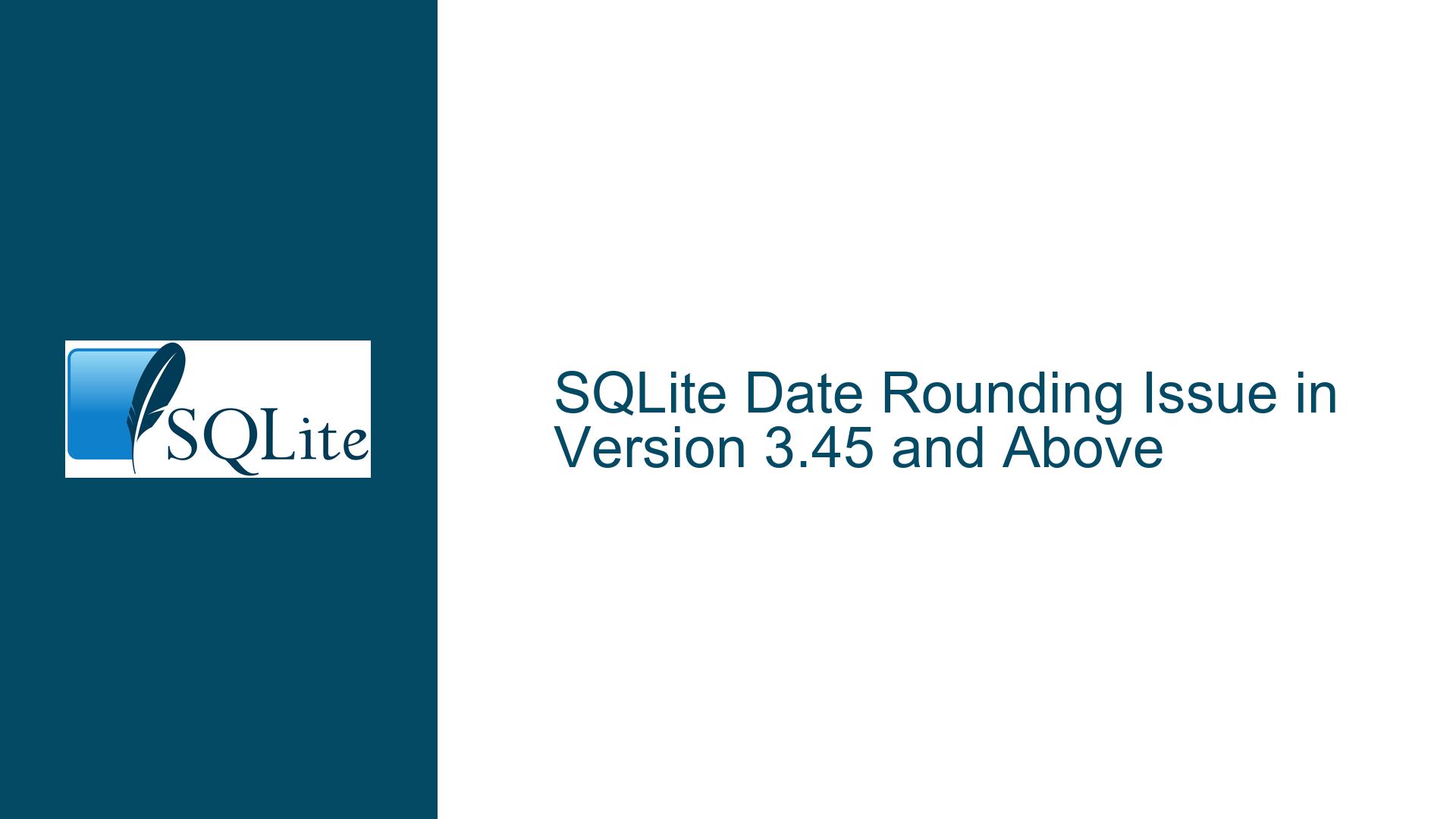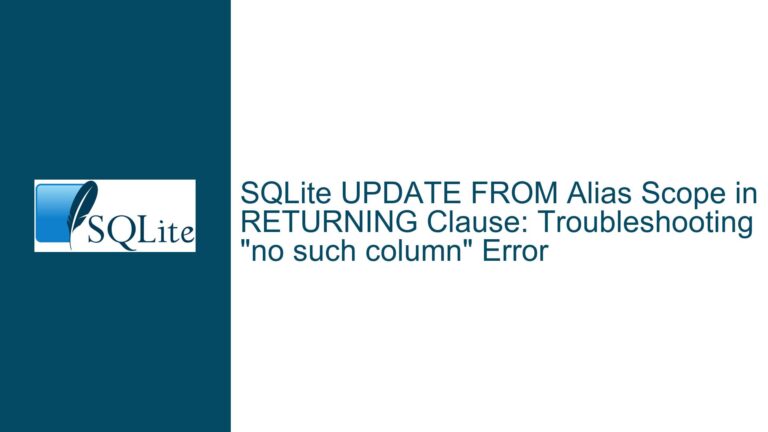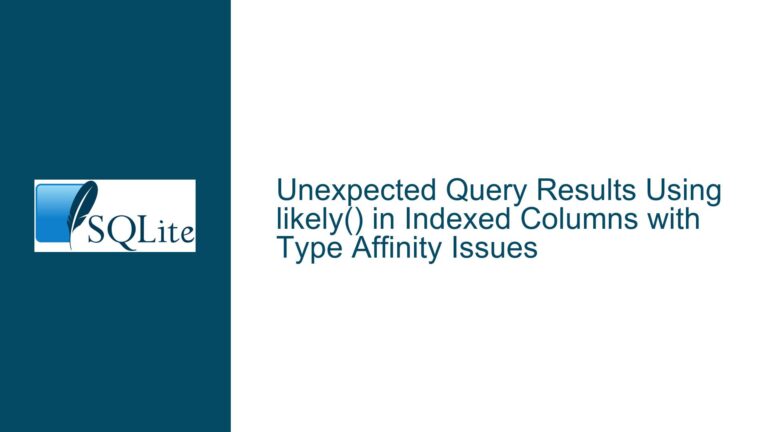SQLite Date Rounding Issue in Version 3.45 and Above
Issue Overview: Date and Time Rounding Inconsistencies in SQLite 3.45
The core issue revolves around the inconsistent handling of datetime values in SQLite, specifically when dealing with timestamps that end in 23:59:59.9995. This behavior was introduced in SQLite version 3.45 and has led to unexpected results when using SQLite’s date and time functions. The primary inconsistency lies in how SQLite rounds datetime values when the fractional seconds are close to the next day. For example, when a datetime value such as 2024-12-31 23:59:59.9995 is processed, the date portion rounds up to the next day (2025-01-01), while the time portion remains unchanged (23:59:59). This creates a datetime combination that is off by 24 hours, which is not the expected behavior.
The issue manifests across multiple SQLite functions, including date(), time(), datetime(), strftime(), julianday(), and unixepoch(). Each of these functions exhibits slightly different behavior when processing the same datetime value, leading to confusion and potential bugs in applications relying on precise datetime calculations. For instance, the date() function rounds the date up to the next day, while the time() function does not round the time portion. Similarly, the datetime() function rounds the date but leaves the time unchanged, resulting in a datetime value that is inconsistent with the original input.
This behavior is particularly problematic for applications that require high precision in datetime calculations, such as financial systems, scheduling applications, or scientific data processing. The rounding inconsistency can lead to incorrect date comparisons, inaccurate time differences, and other datetime-related errors. Furthermore, the issue is exacerbated when dealing with datetime values that are close to the boundaries of a day, month, or year, as the rounding behavior can cause unexpected shifts in the reported date or time.
Possible Causes: Fractional Second Handling and Rounding Logic in SQLite
The root cause of this issue lies in how SQLite handles fractional seconds and applies rounding logic to datetime values. In SQLite, datetime values are typically stored as strings in the YYYY-MM-DD HH:MM:SS.SSS format, where SSS represents the fractional seconds. When processing these values, SQLite converts them into an internal representation that facilitates date and time calculations. However, the rounding logic applied during this conversion appears to be inconsistent, particularly for datetime values that are very close to the next day.
One possible cause of the issue is the way SQLite handles the transition between days. When a datetime value such as 2024-12-31 23:59:59.9995 is processed, SQLite may internally convert the fractional seconds into a floating-point number, which is then used to determine whether the value should be rounded up to the next day. However, due to the limitations of floating-point arithmetic, the rounding logic may not be applied consistently across all datetime functions. This can result in the date portion being rounded up while the time portion remains unchanged, leading to the observed inconsistency.
Another potential cause is the way SQLite’s datetime functions handle edge cases. In SQLite, the date() function is designed to extract the date portion of a datetime value, while the time() function extracts the time portion. The datetime() function, on the other hand, is designed to return the full datetime value. However, the rounding logic applied by these functions may differ, leading to inconsistent results when processing datetime values that are close to the next day. For example, the date() function may round the date up to the next day, while the time() function may leave the time portion unchanged, resulting in a datetime value that is off by 24 hours.
Additionally, the issue may be related to the way SQLite handles the transition between different datetime formats. SQLite supports multiple datetime formats, including the YYYY-MM-DD HH:MM:SS.SSS format, the Julian Day format, and the Unix epoch format. When converting between these formats, SQLite may apply different rounding rules, leading to inconsistencies in the reported datetime values. For example, the julianday() function may round the datetime value up to the next day, while the unixepoch() function may round it down, depending on the fractional seconds.
Troubleshooting Steps, Solutions & Fixes: Addressing Date and Time Rounding Inconsistencies
To address the date and time rounding inconsistencies in SQLite, several troubleshooting steps and solutions can be implemented. These steps are designed to help identify the root cause of the issue, mitigate its impact, and provide a long-term fix for the problem.
1. Verify SQLite Version and Apply Updates:
The first step in troubleshooting this issue is to verify the version of SQLite being used. As noted in the discussion, the rounding issue was introduced in SQLite version 3.45 and has been resolved in version 3.48. Therefore, it is essential to check the current version of SQLite and update it to the latest version if necessary. This can be done by running the following command in the SQLite shell:
SELECT sqlite_version();
If the version is earlier than 3.48, it is recommended to update SQLite to the latest version. This can be done by downloading the latest version from the official SQLite website and following the installation instructions. Updating SQLite to version 3.48 or later should resolve the rounding issue and ensure consistent behavior across all datetime functions.
2. Review and Adjust Datetime Input Formats:
Another important step in troubleshooting this issue is to review the format of the datetime values being used in the application. SQLite supports multiple datetime formats, and the rounding behavior may vary depending on the format used. To ensure consistent behavior, it is recommended to use the YYYY-MM-DD HH:MM:SS.SSS format for all datetime values. This format provides the highest level of precision and ensures that the fractional seconds are handled correctly.
If the application is using a different datetime format, it may be necessary to convert the datetime values to the YYYY-MM-DD HH:MM:SS.SSS format before processing them with SQLite’s datetime functions. This can be done using the strftime() function, which allows for precise control over the format of the datetime values. For example, the following query converts a datetime value to the YYYY-MM-DD HH:MM:SS.SSS format:
SELECT strftime('%Y-%m-%d %H:%M:%S', '2024-12-31 23:59:59.9995');
By ensuring that all datetime values are in the correct format, the application can avoid inconsistencies in the rounding behavior and ensure accurate datetime calculations.
3. Implement Custom Rounding Logic:
In some cases, it may be necessary to implement custom rounding logic to address the inconsistencies in SQLite’s datetime functions. This can be done by creating a user-defined function (UDF) that applies the desired rounding behavior to datetime values. For example, the following UDF rounds a datetime value to the nearest second:
CREATE FUNCTION round_datetime(datetime TEXT) RETURNS TEXT AS $$
BEGIN
RETURN strftime('%Y-%m-%d %H:%M:%S', datetime);
END;
$$;
This UDF can be used in place of SQLite’s built-in datetime functions to ensure consistent rounding behavior. For example, the following query uses the custom rounding function to process a datetime value:
SELECT round_datetime('2024-12-31 23:59:59.9995');
By implementing custom rounding logic, the application can ensure that datetime values are processed consistently and avoid the rounding inconsistencies introduced in SQLite 3.45.
4. Use Alternative Datetime Functions:
If updating SQLite or implementing custom rounding logic is not feasible, another option is to use alternative datetime functions that do not exhibit the rounding issue. For example, the strftime() function can be used to extract the date and time portions of a datetime value without applying any rounding. The following query uses the strftime() function to extract the date and time portions of a datetime value:
SELECT strftime('%Y-%m-%d', '2024-12-31 23:59:59.9995') AS date,
strftime('%H:%M:%S', '2024-12-31 23:59:59.9995') AS time;
By using the strftime() function, the application can avoid the rounding inconsistencies introduced in SQLite 3.45 and ensure accurate datetime calculations.
5. Test and Validate Datetime Calculations:
Finally, it is essential to thoroughly test and validate all datetime calculations in the application to ensure that they are not affected by the rounding issue. This can be done by creating a set of test cases that cover various datetime values, including those that are close to the boundaries of a day, month, or year. The following query demonstrates how to create a test case for a datetime value that is close to the next day:
SELECT '2024-12-31 23:59:59.9995' AS input,
date('2024-12-31 23:59:59.9995') AS date_output,
time('2024-12-31 23:59:59.9995') AS time_output,
datetime('2024-12-31 23:59:59.9995') AS datetime_output;
By running these test cases, the application can identify any inconsistencies in the datetime calculations and take appropriate action to address them.
In conclusion, the date and time rounding inconsistencies in SQLite 3.45 can be addressed by verifying the SQLite version, reviewing and adjusting datetime input formats, implementing custom rounding logic, using alternative datetime functions, and thoroughly testing and validating datetime calculations. By following these steps, the application can ensure accurate and consistent datetime calculations and avoid the issues introduced in SQLite 3.45.






